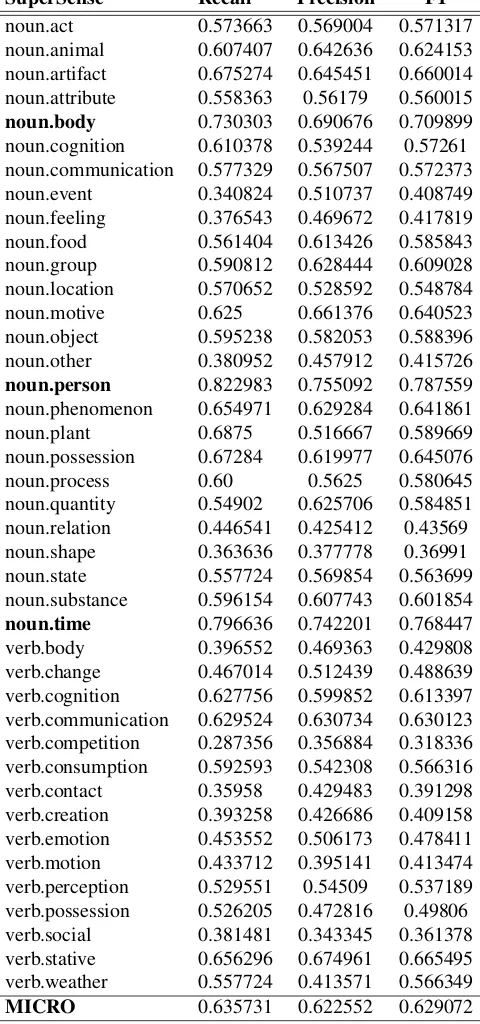cerning verb categories, the results are less accurate. This phenomena can be explained considering the fact that verbs are much more ambiguous than nouns.
5.
Conclusion and future work
In this paper we presented a new Italian SuperSense Tag-ger able to recognize named entities and concepts in texts achieving reasonably high accuracy, even if much lower than the English counterpart. Anyhow, the achieved pre-cision is reasonably high for the tagger to be applied in knowledge acquisition tasks.
These results are encouraging and this research deserves further investigations. First of all we are going to develop automatic techniques based on parallel corpora to develop SST for other languages, such as German and French, with-out exploiting any labeled data. Secondly, combing this tagger with the English one already developed, we offer a new multilingual tool, covering an higher spectrum of cate-gories than traditional Named Entity Recognition systems. Being the category set totally aligned among languages, the tool can be profitably used as a preprocessing step for bilin-gual dictionary induction, multilinbilin-gual ontology learning, and so on. Another direction we are following is the de-velopment of a new generation SST which is able to dis-tinguish between concepts and instances of the same type. Finally, we are going to develop a WEB service able to ex-tract terminology belonging to different supersenses from the analysis of corpora and WEB pages in multiple lan-guages.
Acknowledgments
Alfio Massimiliano Gliozzo has been supported by the BONy project, financed by the Education and culture DG of the EU, grant agreement N 135263-2007-IT-KA3-KA3MP, under the Lifelong Learning Programme 2007 managed by EACEA.
6.
References
Luisa Bentivogli, Pamela Forner, and Emanuele Pianta. 2004. Evaluating cross-language annotation transfer in the multisemcor corpus. InCOLING ’04: Proceedings of the 20th international conference on Computational Linguistics, page 364, Morristown, NJ, USA. Associa-tion for ComputaAssocia-tional Linguistics.
M. Ciaramita and Y. Altun. 2006. Broad-coverage sense disambiguation and information extraction with a super-sense sequence tagger. In Proceedings of EMNLP-06, pages 594–602, Sydney, Australia.
M. Ciaramita and J. Atserias. 2007. Pos tagging with a named entity tagger.Intelligenza Artificiale, 4:28–29. M. Ciaramita and M. Johnson. 2003. Supersense
tag-ging of unknown nouns in wordnet. In Proceedings of EMNLP-03, pages 168–175, Sapporo, Japan.
M. Collins. 2002. Discriminative training methods for hid-den markov models: Theory and experiments with per-ceptron algorithms. InProceedings of EMNLP-02. C. Fellbaum. 1998. WordNet. An Electronic Lexical
Database. MIT Press.
Ralph Grishman and Beth Sundheim. 1996. Message un-derstanding conference-6: a brief history. In Proceed-ings of the 16th conference on Computational linguis-tics, pages 466–471, Morristown, NJ, USA. Association for Computational Linguistics.
T. Koo and M. Collins. 2005. Hidden-variable models for discriminative reranking. InProceedings of EMNLP-05, Vancouver, Canada.
G. A. Miller. 1990. Nouns in wordnet: a lexical inher-itance system,. International Journal of Lexicography, 3(4):245–264.
Nam Nguyen and Yunsong Guo. 2007. Comparison of se-quence labeling algorithms and extensions. In Proceed-ings of ICML 2007, pages 681–688.
Davide Picca, Alfio Gliozzo, and Massimiliano Ciaramita. May 2007. Semantic domains and supersens tagging for domain-specific ontology learning. Inproceedings RIAO 2007.

